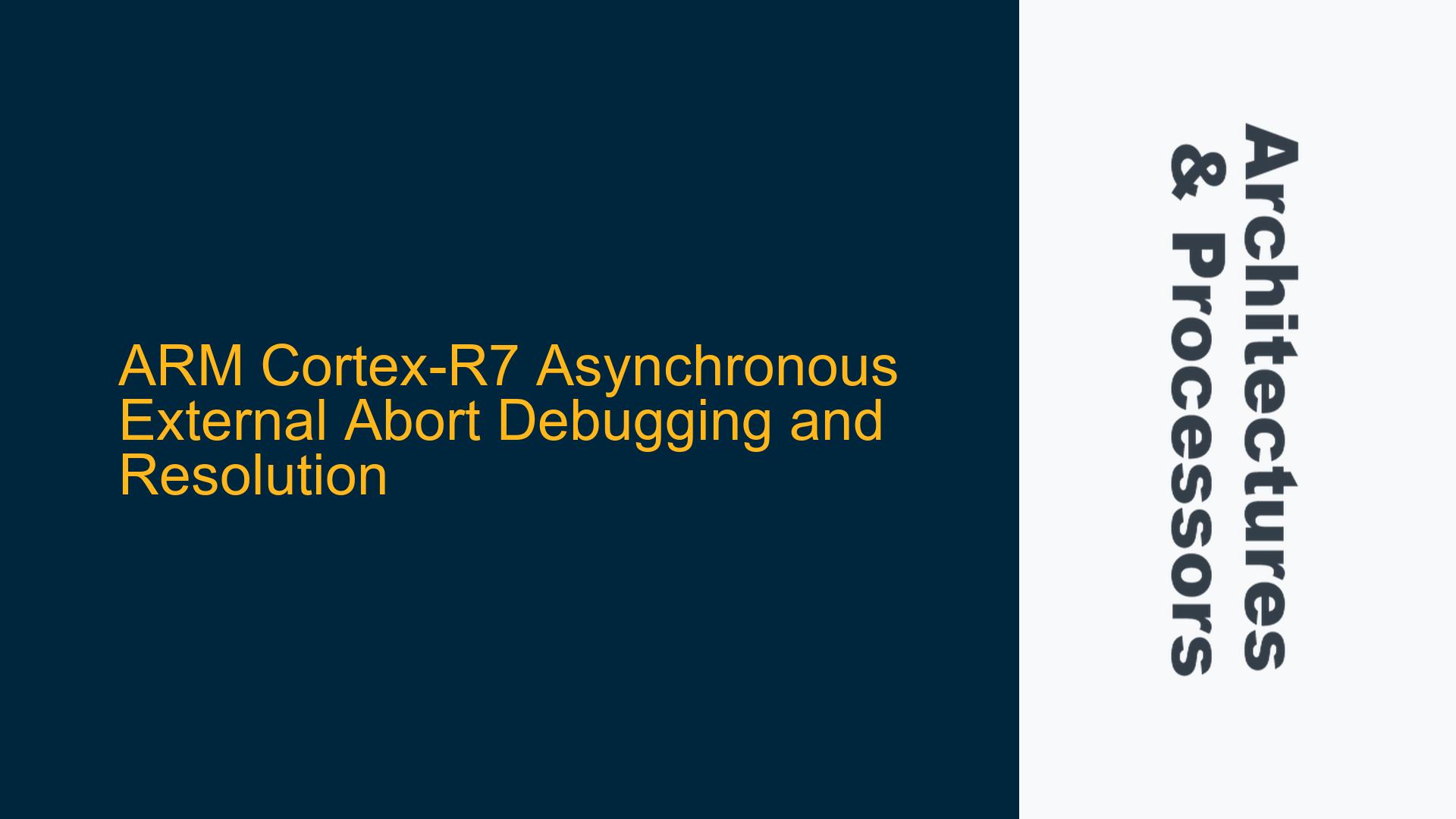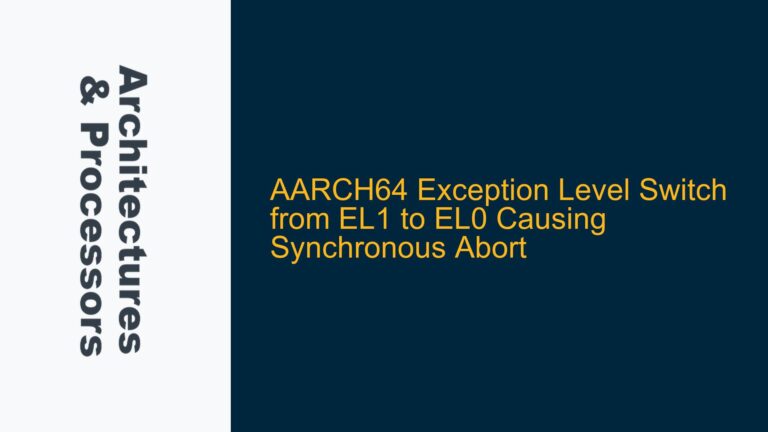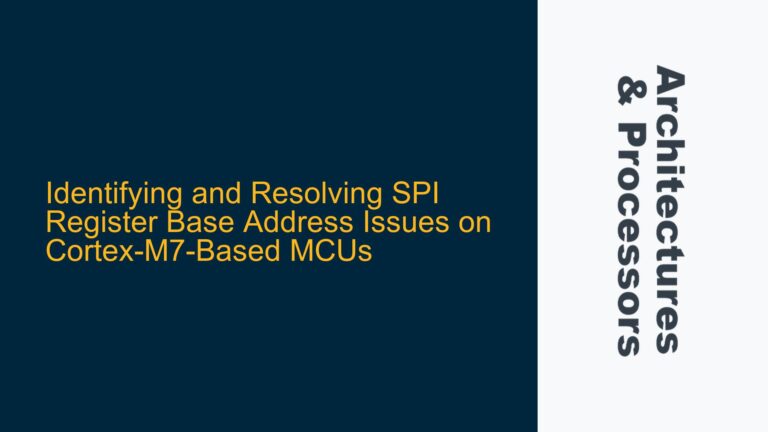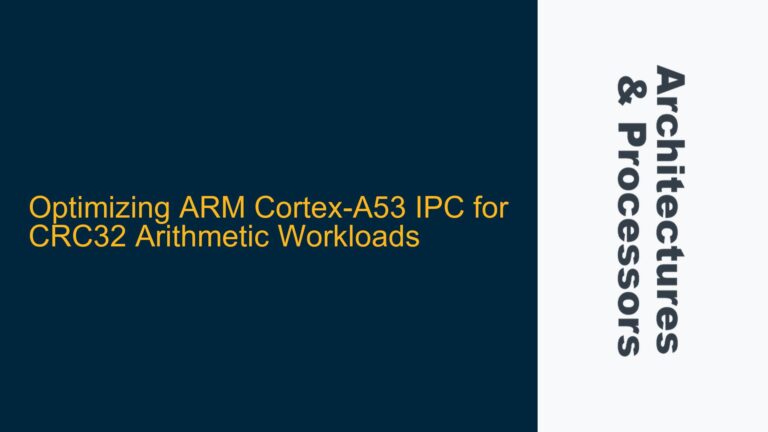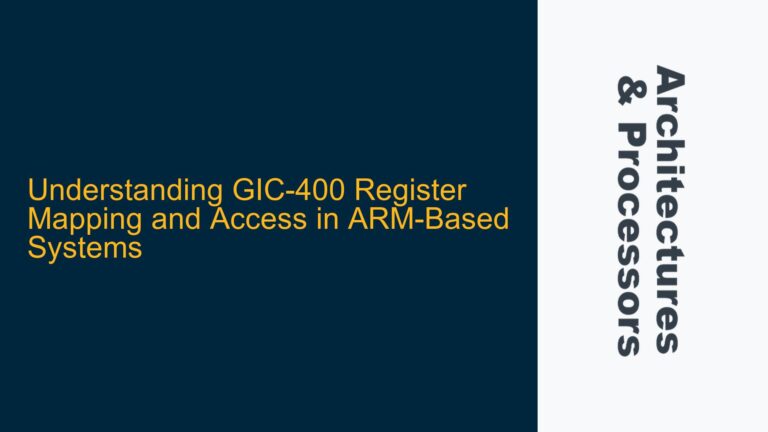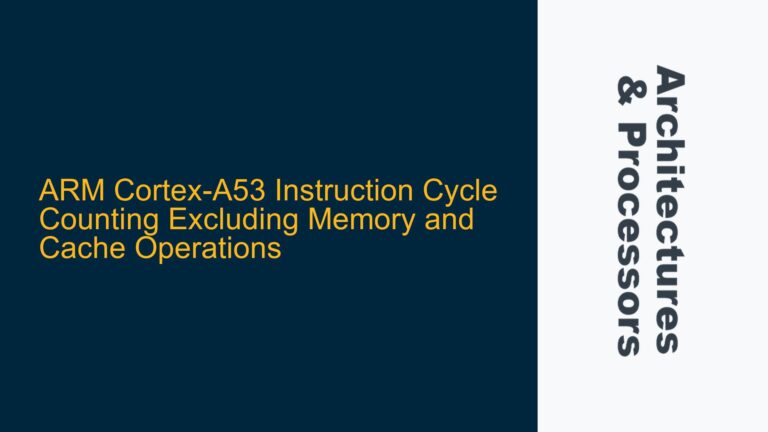ARM Cortex-R7 Asynchronous External Abort: Understanding the Exception
The ARM Cortex-R7 processor is designed for real-time and safety-critical applications, where reliability and fault tolerance are paramount. However, one of the more challenging issues to debug on this platform is the Asynchronous External Abort. This exception is particularly insidious because it does not occur as a direct result of the instruction being executed at the time of the fault. Instead, it is triggered by an external event, such as a memory access error or a cache coherency issue, which may have occurred some time before the exception is actually raised.
The key characteristics of an Asynchronous External Abort are as follows:
- The exception is not directly tied to the instruction being executed when the abort occurs.
- The Data Fault Status Register (DFSR) provides information about the type of fault. In this case, the DFSR value is 0x1406, which indicates an External Abort with a fault status of 0b10110 (Asynchronous External Abort).
- The Data Fault Address Register (DFAR) is typically UNKNOWN for asynchronous faults, as the faulting address cannot be reliably determined.
- The Auxiliary Data Fault Status Register (ADFSR) and Auxiliary Instruction Fault Status Register (AIFSR) are often 0x0, providing no additional information.
The challenge in debugging this issue lies in the asynchronous nature of the fault. The fault could have been caused by a memory access that occurred several instructions before the exception was raised, making it difficult to trace back to the root cause. Additionally, the fault could be related to interactions between the Cortex-R7 and other components in the system, such as the CA5x CPUs or the RCAR SoC‘s memory subsystem.
Memory Access Errors and Cache Coherency Issues in RCAR SoC
The Asynchronous External Abort in the Cortex-R7 can be caused by a variety of factors, but the most common culprits are memory access errors and cache coherency issues. In the context of the RCAR SoC, which integrates multiple CPU cores and a complex memory hierarchy, these issues can be particularly challenging to diagnose.
Memory Access Errors
Memory access errors can occur when the Cortex-R7 attempts to access a memory location that is either invalid or inaccessible. This could be due to:
- Invalid Memory Address: The Cortex-R7 may attempt to access a memory address that is not mapped or is outside the valid address range. This could be caused by a software bug, such as a pointer dereference error or an incorrect memory mapping configuration.
- Memory Protection Violation: The Cortex-R7 may attempt to access a memory region that is protected by the Memory Protection Unit (MPU) or the Memory Management Unit (MMU). This could be due to an incorrect MPU/MMU configuration or a software bug that bypasses the protection mechanisms.
- Bus Error: The Cortex-R7 may encounter a bus error when attempting to access a memory location. This could be caused by a hardware issue, such as a faulty memory module or a misconfigured bus interface.
Cache Coherency Issues
Cache coherency issues can arise when multiple processors or DMA controllers access the same memory location without proper synchronization. In the RCAR SoC, the Cortex-R7 may share memory with other CPU cores (such as the CA5x CPUs) or with DMA controllers. If the cache coherency mechanisms are not properly managed, it can lead to inconsistent memory views and, ultimately, an Asynchronous External Abort.
- DMA and Cache Coherency: If a DMA controller writes to a memory location that is cached by the Cortex-R7, the cache may become stale. If the Cortex-R7 subsequently reads from that memory location, it may encounter an Asynchronous External Abort due to the stale cache data.
- Multi-Core Cache Coherency: If multiple CPU cores (such as the Cortex-R7 and CA5x CPUs) access the same memory location without proper synchronization, it can lead to cache coherency issues. For example, if one core modifies a memory location while another core has a cached copy of the old data, it can result in an Asynchronous External Abort when the second core attempts to access the stale data.
Masking Asynchronous Exceptions
Masking Asynchronous Exceptions by setting the CPSR.A bit can prevent the Cortex-R7 from raising the exception. However, this approach has several potential drawbacks:
- Silent Data Corruption: If the Asynchronous External Abort is caused by a memory access error or cache coherency issue, masking the exception may allow the system to continue operating with corrupted data. This can lead to unpredictable behavior and potentially catastrophic failures.
- Debugging Challenges: Masking the exception makes it more difficult to diagnose the root cause of the issue, as the fault will no longer be reported. This can make it harder to identify and fix the underlying problem.
- System Stability: Ignoring the exception may lead to further instability, as the underlying issue may cause additional faults or exceptions in the future.
Debugging and Resolving Asynchronous External Abort in Cortex-R7
Debugging an Asynchronous External Abort in the Cortex-R7 requires a systematic approach to identify and resolve the root cause. The following steps outline a comprehensive strategy for diagnosing and fixing this issue.
Step 1: Analyze the DFSR and DFAR Registers
The Data Fault Status Register (DFSR) and Data Fault Address Register (DFAR) provide critical information about the nature of the fault. In this case, the DFSR value is 0x1406, which indicates an External Abort with a fault status of 0b10110 (Asynchronous External Abort). The DFAR is UNKNOWN, which is expected for asynchronous faults.
- DFSR Analysis: The DFSR value 0x1406 indicates that the fault is an External Abort and is asynchronous. This suggests that the fault is not directly related to the instruction being executed at the time of the exception.
- DFAR Analysis: The DFAR is UNKNOWN, which means that the faulting address cannot be determined. This is typical for asynchronous faults, as the fault may have occurred some time before the exception was raised.
Step 2: Investigate Memory Access Patterns
Given that the fault is likely related to memory access, the next step is to investigate the memory access patterns of the Cortex-R7. This includes:
- Memory Mapping: Verify that the memory mappings in the MPU/MMU are correctly configured and that the Cortex-R7 is not attempting to access invalid or protected memory regions.
- Pointer Dereferencing: Check for any potential pointer dereference errors in the software that could lead to invalid memory accesses.
- DMA and Cache Coherency: If DMA is used in the system, ensure that proper cache coherency mechanisms are in place. This may involve using Data Synchronization Barriers (DSB) and Data Memory Barriers (DMB) to ensure that DMA writes are visible to the Cortex-R7.
Step 3: Implement Data Synchronization Barriers (DSB) and Data Memory Barriers (DMB)
To ensure that memory accesses are properly synchronized, it is important to use Data Synchronization Barriers (DSB) and Data Memory Barriers (DMB) in the code. These instructions ensure that all memory accesses before the barrier are completed before any memory accesses after the barrier are executed.
- DSB: The DSB instruction ensures that all memory accesses before the barrier are completed before any subsequent instructions are executed. This is particularly important when dealing with DMA and cache coherency issues.
- DMB: The DMB instruction ensures that memory accesses before the barrier are completed before any memory accesses after the barrier are executed. This is useful for ensuring that memory accesses are properly ordered.
Step 4: Check for Cache Coherency Issues
Cache coherency issues can be a common cause of Asynchronous External Abort in systems with multiple processors or DMA controllers. To address this, it is important to:
- Invalidate Caches: Ensure that caches are properly invalidated when necessary, particularly after DMA writes. This can be done using the Invalidate Cache instruction.
- Cache Maintenance Operations: Use cache maintenance operations to ensure that the cache is consistent with the main memory. This may involve using the Clean and Invalidate Cache instruction to ensure that any dirty cache lines are written back to memory.
Step 5: Verify System-Level Interactions
In a complex system like the RCAR SoC, interactions between different components (such as the Cortex-R7 and CA5x CPUs) can lead to Asynchronous External Abort. To address this, it is important to:
- Check for Cross-Core Effects: Verify that the behavior of the CA5x CPUs is not causing issues for the Cortex-R7. This may involve checking for any shared memory regions or resources that could lead to conflicts.
- System-Level Debugging: Use system-level debugging tools to monitor the interactions between the Cortex-R7 and other components in the system. This may involve using hardware probes or logic analyzers to capture the system’s behavior.
Step 6: Consider Masking Asynchronous Exceptions (with Caution)
If the root cause of the Asynchronous External Abort cannot be identified, it may be necessary to mask the exception by setting the CPSR.A bit. However, this should be done with caution, as it can lead to silent data corruption and make it more difficult to diagnose the underlying issue.
- Silent Data Corruption: Masking the exception may allow the system to continue operating with corrupted data, which can lead to unpredictable behavior.
- Debugging Challenges: Masking the exception makes it more difficult to diagnose the root cause of the issue, as the fault will no longer be reported.
- System Stability: Ignoring the exception may lead to further instability, as the underlying issue may cause additional faults or exceptions in the future.
Step 7: Implement Robust Error Handling
To ensure that the system can recover from Asynchronous External Abort, it is important to implement robust error handling mechanisms. This includes:
- Exception Handling: Implement an exception handler that can capture and log the relevant registers (such as the DFSR and DFAR) when an Asynchronous External Abort occurs. This information can be used to diagnose the issue.
- System Recovery: Implement a system recovery mechanism that can reset the system or restart the affected task if an Asynchronous External Abort occurs. This can help to ensure that the system remains operational even in the presence of faults.
Step 8: Perform System-Level Testing
Finally, it is important to perform system-level testing to ensure that the Asynchronous External Abort has been resolved. This includes:
- Stress Testing: Perform stress testing to ensure that the system can handle high loads and complex interactions without encountering Asynchronous External Abort.
- Fault Injection: Use fault injection techniques to simulate memory access errors and cache coherency issues, and verify that the system can handle these faults gracefully.
By following these steps, it is possible to diagnose and resolve Asynchronous External Abort in the ARM Cortex-R7. While the asynchronous nature of the fault makes it challenging to debug, a systematic approach that includes memory access analysis, cache coherency management, and robust error handling can help to identify and fix the underlying issue.
